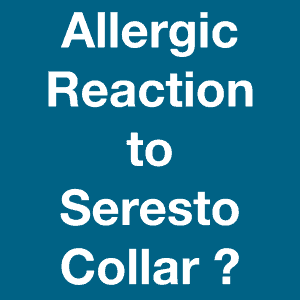
If your dog has all the symptoms of an allergic reaction at the Seresto collar you just bought, don’t hesitate to take it down.
Even if it was the vet that recommended that particular type of collar and the manufacturers swear it’s perfectly safe for pets, there have been simply too many incidents with these products to ignore the risks.
And, yes, the pesticides in Seresto collars can be harmful to humans, as well.
In this article, we’ll have an in-depth look at the chemicals in the Seresto collars and the symptoms associated with an allergic reaction that you should be aware of.
We’ll also tell you what to do if your pet has a reaction to the new collar.
What are Seresto collars?
Seresto collars were launched in 2012 and they became quite popular as they offer protection against both fleas and ticks.
At the same time, they are said to have a slow-release mechanism so the protection they offer lasts up to 8 months.
The Seresto collar was developed by Bayer and is sold in the US by Elanco.
Flea collars have been around for decades and many pet owners prefer them as they’re very convenient.
Topical products need to be applied every month.
Same thing if you use pills.
For many it can be quite a hassle, whereas collars are easy.
You just put a flea collar on your dog’s neck and you don’t have to worry about a thing for a long time.
The 8 months protection Seresto collars boast pretty much covers the warm months when cats and dogs are more likely to get fleas, so this makes them just perfect.
What are the active ingredients in Seresto collars?
Seresto collars were marketed as a major innovation as they contain two active ingredients: imidacloprid and flumethrin, both of them pesticides.
Imidacloprid is a member of the neonicotinoid class of insecticides and kills fleas by attacking their central nervous system.
Flumethrin belongs to the pyrethroid class and it repels and kills ticks.
According to the US Environmental Protection Agency (EPA) flumethrin is more likely to cause skin irritations and allergic reactions, in both pets and humans. For the time being, the EPA maintains that Seresto collars are safe and the problems observed are of no concern.
The pesticides in the Seresto collar are supposed to be trapped in the oil and oil glands in the dog’s fur, with little to no absorption into the skin.
Oddly enough, if you look on Amazon at the product description at the top of the page, they only list Imidacloprid under Ingredients. They mention Flumethrin only at the bottom of the page, in the FAQ section, if you bother to scroll to the end. If you don’t, well, that’s your problem.
On the other hand, if you look at the reviews, you’ll notice that many customers complain that their pets had an allergic reaction to the Seresto collar.
Allergic reaction to Seresto collars in dogs by the numbers
If you look at the numbers, they’re staggering. Between 2012 and 2020, the EPA received more than 75,000 reports of incidents related to Seresto collars, USA Today reported in a powerful March 2021 article on Seresto collars. Close to 1,700 pet deaths were reported for the same period
These incidents were all reported by pet owners, so, at this point, there’s no official confirmation of a link between Seresto collars and the death of thousands of pets. That’s the official line, anyway.
On the other hand, if you have a look at the USA Today article mentioned above you’ll see the tragic story of one American woman who watched her dog collapse and die in front of her one day after she put a Seresto collar on him.
The same goes for the effects on humans handling Seresto collars. The EPA has received hundreds of complaints of harmful reactions, but according to the agency all these incidents are self-reported so they don’t hold any scientific value.
What are the side effects of the Seresto collar?
According to the manufacturers, Seresto collars are safe, yet experts agree there’s no way to predict if a pet will have some reaction to such a product unless you try it on. Here’s what signs you should look out for:
- Redness or skin irritation on the neck
- Hair loss, also in the area where the collar sits
- Reduced appetite
- Vomiting or diarrhea
- Behavioral changes, such as excessive scratching at the collar or restlessness
These symptoms might appear within a few hours or days after you put the collar on the dog. Some of them might be caused by the simple mechanical action of the collar on the dog’s neck. The collar rubbing against the fur can lead to redness or hair loss. Likewise, the dog might be bothered by the collar being too tight or feeling unfamiliar and this is why he scratches at it like that.
On the other hand, you cannot ignore the risk that he’s having an allergic reaction.
What are the symptoms of allergic reactions in dogs?
Just like humans, dogs can be allergic to many things, foods, household chemicals, or even fleas.
The side effects mentioned above are typical for an allergic reaction, but there are other symptoms that might indicate a bad reaction to a Seresto collar. Here are some of them:
- Watery eyes
- Runny nose
- Sneezing/Coughing/Wheezing
- Respiratory distress
- Hives
- Lethargy
How to treat allergies in dogs?
If the dog has any symptoms suggesting an allergic reaction, you should take off the Seresto collar right away. What you do next depends on the severity of the symptoms.
If your dog has skin inflammation at the site of the collar, you can try giving a soothing bath with a hypoallergenic shampoo. This should help wash away the pesticides in his fur. Oatmeal and aloe vera can help soothe the itchiness. The water should be tepid and you should let the dog soak in the bathtub for at least five minutes.
Pat him dry with a towel and wait for the irritation to subside.
On the other hand, if the dog has a really bad reaction and is in respiratory distress, there’s no time to give him a bath. Take the collar off and head to the vet straight away. If the dog cannot breathe he might need to be put on oxygen. In most cases, the vet will prescribe an antihistamine and a topical ointment.
Can humans be allergic to Seresto collars?
As mentioned above, the EPA received hundreds of complaints concerning allergic reactions in humans. The manufacturers themselves advise you should wash your hands thoroughly after touching the dog’s collar. Also, the product comes with a warning that you should not let children touch the collar. And you should avoid letting your dog share your bed once you put a Seresto collar on him.
Judging by these warnings, it is obvious that they are fully aware the pesticides in the dog’s collar can trigger a skin reaction, if not a full-blown allergic reaction.
Are Seresto collars dangerous?
If you ask the manufacturers or the EPA, no. According to them, some dogs or, indeed, humans, are more sensitive to certain chemical compounds, which should explain the allergic reactions reported. However, many people warn the problems with Seresto are quite serious.
“The EPA appears to be turning a blind eye to this problem, and after seven years of an increasing number of incidents, they are telling the public that they are continuing to monitor the situation. But I think this is a significant problem that needs to be addressed sooner rather than later,” says Karen McCormack, a retired EPA employee who worked as both a scientist and communications officer, quoted by USA Today.
As we’ve seen with many other drugs for human or pet consumption, sometimes it takes years before authorities decide to act on the complaints they receive.
Is there a Seresto collar recall?
Many pet owners want to know whether there’s been a Seresto collar recall. Not at this point, but looking at the numbers it might be just a question of time before they do so.
Soon after the USA Today’s investigative report on Seresto collars, on March 17, Rep. Raja Krishnamoorthi, chairman of the subcommittee on Economic and Consumer Policy, contacted the company that sells Seresto collars. In the letter sent out, she asked the Elanco company to recall the product and issue full refunds to customers. Similar letters were sent to the Bayer company, with the request that they release information about the toxicity of the product.
Also, two US pet owners filed a class-action lawsuit against Elanco, claiming that their pets died or suffered terrible reactions after wearing Seresto collars.
Closing Thoughts
Seresto collars claim to offer 8 months protection against fleas and ticks, but it comes at a cost. The collars contain two pesticides which can cause an allergic reaction in dogs. The EPA has received thousands of complaints concerning allergic reactions as well as the death of 1,700 pets, but so far no action has been taken.
Ultimately, it is up to each pet parent to decide what they want to do – continue to trust the official line or take action now. There are after all other types of flea protection for your dog. None of them is without risks, but other products on the market are less controversial.
If your dog had skin irritations or hair loss associated with a Seresto collar, you should talk to your vet about your concerns. They might be able to recommend another form of flea protection.
Maybe the EPA will issue a recall, maybe it won’t, but why should you gamble with your dog’s health when there are other options?





